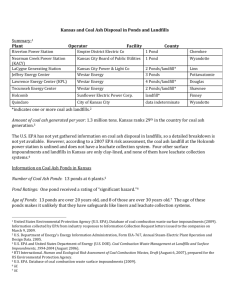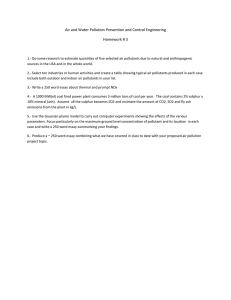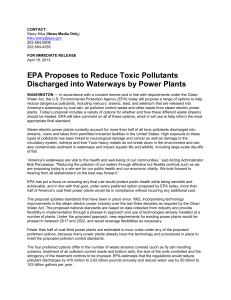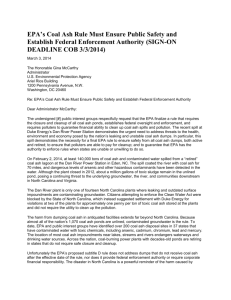COAL ASH DISPOSAL AND REUSE IN WISCONSIN
advertisement
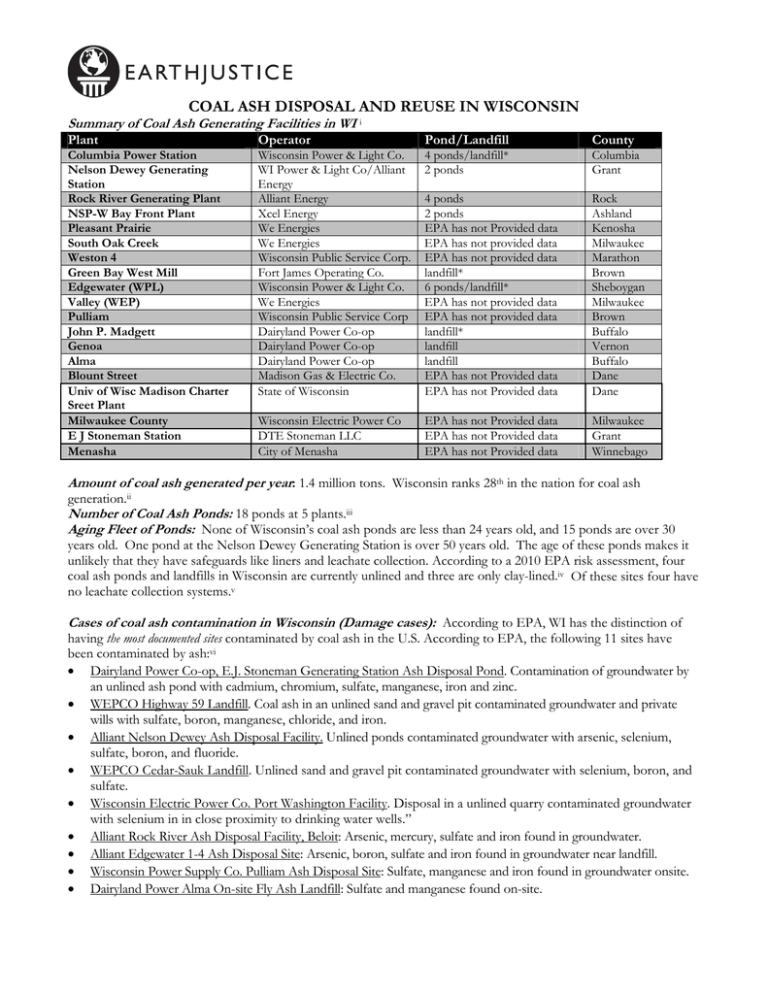
COAL ASH DISPOSAL AND REUSE IN WISCONSIN Summary of Coal Ash Generating Facilities in WI i Plant Operator Pond/Landfill County Columbia Power Station Nelson Dewey Generating Station Rock River Generating Plant NSP-W Bay Front Plant Pleasant Prairie South Oak Creek Weston 4 Green Bay West Mill Edgewater (WPL) Valley (WEP) Pulliam John P. Madgett Genoa Alma Blount Street Univ of Wisc Madison Charter Sreet Plant Milwaukee County E J Stoneman Station Menasha Wisconsin Power & Light Co. WI Power & Light Co/Alliant Energy Alliant Energy Xcel Energy We Energies We Energies Wisconsin Public Service Corp. Fort James Operating Co. Wisconsin Power & Light Co. We Energies Wisconsin Public Service Corp Dairyland Power Co-op Dairyland Power Co-op Dairyland Power Co-op Madison Gas & Electric Co. State of Wisconsin 4 ponds/landfill* 2 ponds Columbia Grant 4 ponds 2 ponds EPA has not Provided data EPA has not provided data EPA has not provided data landfill* 6 ponds/landfill* EPA has not provided data EPA has not provided data landfill* landfill landfill EPA has not Provided data EPA has not Provided data Rock Ashland Kenosha Milwaukee Marathon Brown Sheboygan Milwaukee Brown Buffalo Vernon Buffalo Dane Dane Wisconsin Electric Power Co DTE Stoneman LLC City of Menasha EPA has not Provided data EPA has not Provided data EPA has not Provided data Milwaukee Grant Winnebago Amount of coal ash generated per year: 1.4 million tons. Wisconsin ranks 28th in the nation for coal ash generation.ii Number of Coal Ash Ponds: 18 ponds at 5 plants.iii Aging Fleet of Ponds: None of Wisconsin’s coal ash ponds are less than 24 years old, and 15 ponds are over 30 years old. One pond at the Nelson Dewey Generating Station is over 50 years old. The age of these ponds makes it unlikely that they have safeguards like liners and leachate collection. According to a 2010 EPA risk assessment, four coal ash ponds and landfills in Wisconsin are currently unlined and three are only clay-lined.iv Of these sites four have no leachate collection systems.v Cases of coal ash contamination in Wisconsin (Damage cases): According to EPA, WI has the distinction of having the most documented sites contaminated by coal ash in the U.S. According to EPA, the following 11 sites have been contaminated by ash:vi Dairyland Power Co-op, E.J. Stoneman Generating Station Ash Disposal Pond. Contamination of groundwater by an unlined ash pond with cadmium, chromium, sulfate, manganese, iron and zinc. WEPCO Highway 59 Landfill. Coal ash in an unlined sand and gravel pit contaminated groundwater and private wills with sulfate, boron, manganese, chloride, and iron. Alliant Nelson Dewey Ash Disposal Facility. Unlined ponds contaminated groundwater with arsenic, selenium, sulfate, boron, and fluoride. WEPCO Cedar-Sauk Landfill. Unlined sand and gravel pit contaminated groundwater with selenium, boron, and sulfate. Wisconsin Electric Power Co. Port Washington Facility. Disposal in a unlined quarry contaminated groundwater with selenium in in close proximity to drinking water wells.” Alliant Rock River Ash Disposal Facility, Beloit: Arsenic, mercury, sulfate and iron found in groundwater. Alliant Edgewater 1-4 Ash Disposal Site: Arsenic, boron, sulfate and iron found in groundwater near landfill. Wisconsin Power Supply Co. Pulliam Ash Disposal Site: Sulfate, manganese and iron found in groundwater onsite. Dairyland Power Alma On-site Fly Ash Landfill: Sulfate and manganese found on-site. Dairyland Power Alma Off-site Fly Ash Landfill: Sulfate and manganese found on-site. Lemberger Landfill, Manitowoc County: National Priorities List Superfund Site.vii In addition, Earthjustice, Environmental Integrity Project and Sierra Club, documented two additional sites contaminated by coal ash:viii Columbia Energy Center, WI Power and Light Co, Pardeeville: Ecological studies in the late 1970s identified devastating impacts on aquatic life in a stream receiving discharge from ash ponds wiping out nearly all aquatic insects for 2.2 miles downstream; and Oak Creek Power Plant, WE Energies, Oak Creek: Twelve private drinking wells near the Oak Creek and Caledonia coal ash landfills have been contaminated with molybdenum. WE Energies started providing bottled water to residents in 2009. We Energies Bluff Collapse: On October 31, 2011, a bluff collapsed at the We Energies Oak Creek Plant in Oak Creek, Wisconsin. Coal ash—along with mud, a pickup truck, dredging equipment, and other debris—gushed into Lake Michigan. Coal ash had been used to fill a ravine on the site over 50 years ago.ix This spill points to the statewide problem of old disposal sites that have not been identified and are not being monitored for potential harm. Wisconsin State Regulatory Program and Recycling of Coal Ash: WI’s program requires Oak Creek Spill groundwater monitoring at many of its disposal sites. WI also requires all landfills be constructed with composite liners. Because of the greater relative stringency of disposal regulations, in comparison to other states, WI utilities have greater incentive to recycle their coal ash. In fact, higher disposal costs in WI have led to a state recycling rate of at least 85%, more than double the average ash recycling rate in all other states (36%).x Regulations in WI, however, could be more protective. The deficiencies in WI regulations include: (1) Groundwater monitoring is discretionary, not mandatory, at landfills. WI ADC s NR 507.04; (2) Regulations do not specify the location and number of wells. WI ADC s NR 507.19(1), (3) Regulations do not specify a post-closure monitoring period. WI ADC s NR 514.06(11), and (4) Daily cover is not required. WI ADC s NR 506.05(2). For more information, contact Lisa Evans, Earthjustice, 781-631-4119, levans@earthjustice.org. i U.S. EPA. Database of coal combustion waste surface impoundments (2009). Information collected by EPA from industry responses to Information Collection Request letters issued to the companies on March 9, 2009. ii U.S. Department of Energyʹs Energy Information Administration Operation and Design Data. 2005.Form EIA‐767, Annual Steam‐Electric Plant Operation and Design Data. 2005. iii Id. iv US EPA, Human and Ecological Risk Assessment of Coal Combustion Wastes, Draft, April 2010. v Id. vi U.S. EPA, Office of Solid Waste. Coal Combustion Waste Damage Case Assessments (July 9, 2007). vii http://www.epa.gov/R5Super/npl/wisconsin/WID980901243.htm. viii Environmental Integrity Project, Earthjustice and the Sierra Club. In Harm’s Way: Lack of Federal Coal Ash Regulations Endangers Americans and their Environment, August 26, 2010, http://earthjustice.org/sites/default/files/files/report‐in‐harms‐way.pdf. ix Meg Jones and Don Behm, “Bluff collapse at pover plant sends dirt, coal ash into lake,” Milwaukee‐Wisconsin Journal Sentinel (Oct. 31, 2011), available at http://www.jsonline.com/news/milwaukee/authorities‐investigate‐bluff‐collapse‐at‐we‐energies‐plant‐132929538.html. See also Rachel Maddow, “in coal ash we trust,” aired November 1, 2010 at http://www.msnbc.msn.com/id/26315908. x U.S. Department of Energy (2004). Coal Combustion Waste Management at Landfill and Surface Impoundments 1994‐2004, DOE/PL‐004, ANL‐EVS/06‐4 at page 5.


